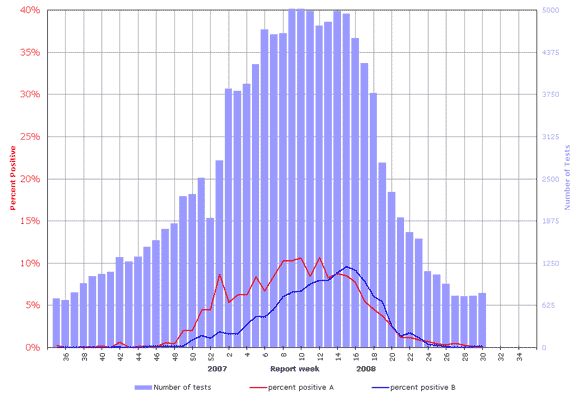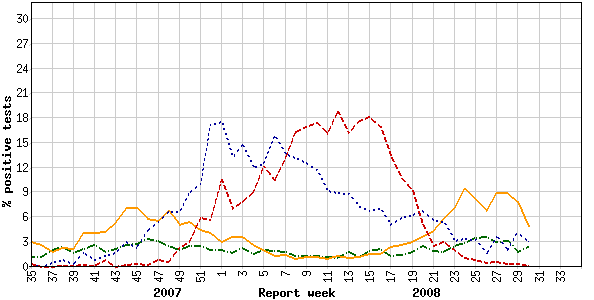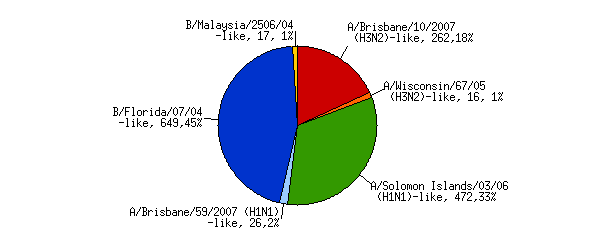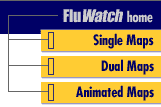Common menu bar links
E-mail this page
Fluwatch
Majority of regions in Canada reporting no influenza activity
During weeks 29 and 30, overall influenza activity in Canada remained low with the majority of the influenza surveillance regions reporting no activity (see map). The percentage of specimens that tested positive for influenza declined to 0.2% (3/1,563) for Canada as a whole over the two-week period (see table). To date this season, 58% of influenza detections in Canada were for influenza A viruses and 42% were for influenza B viruses. Note that parainfluenza virus detections have declined from previous weeks (~ 5% of parainfluenza tests conducted were positive). This week, the ILI consultation rate was 8 ILI consultations per 1,000 patient visits (see ILI graph), which is above the expected range for this week. The sentinel response rate was low at 33%. Fluctuations in ILI consultation rates are expected during periods of low influenza activity and low sentinel participation. No new outbreaks have been reported since week 22.
Antigenic Characterization:
The National Microbiology Laboratory (NML) has characterized 1,442 influenza viruses for the 2007-2008 influenza season: 498 (35%) A(H1N1), 278 (19%) A(H3N2) and 666 (46%) B viruses. Of the 498 influenza A(H1N1) viruses characterized, 472 (95%) were antigenically similar to A/Solomon Islands/3/2006 and 26 (5%) were antigenically similar to A/Brisbane/59/2007. Of the 278 influenza A(H3N2) viruses characterized, 16 (6%) were antigenically similar to A/Wisconsin/67/2005 and 262 (94%) were antigenically similar to A/Brisbane/10/2007. Of the 666 influenza B isolates characterized, 17 (3%) were antigenically similar to B/Malaysia/2506/2004 and 649 (97%) were antigenically similar to B/Florida/4/2006 (belonging to the B/Yamagata lineage) (see pie chart).
Antiviral Resistance:
Since the start of the season, the NML has tested 1,074 influenza A isolates (580 H1N1 and 494 H3N2) for amantadine resistance and found that 492 (99.6%) of the 494 H3N2 isolates were resistant to amantadine and 6 (1%) of 580 H1N1 isolates were resistant (see recommendation from the 2006-2007 influenza season).
The NML has also tested 1,453 influenza isolates (508 A/H1N1, 282 A/H3N2 & 663 B) for oseltamivir (Tamiflu) resistance and found that 134 (26.4%) of the 508 H1N1 isolates tested were resistant to oseltamivir.
Influenza-associated Paediatric Hospitalizations:
In weeks 29 & 30, there were no new laboratory-confirmed influenza-associated paediatric hospitalizations reported through the Immunization Monitoring Program Active (IMPACT) network. For further information, refer to the previous report: http://www.phac-aspc.gc.ca/fluwatch/07-08/w27-28_08/index-eng.php.
International:
WHO: During weeks 28–29, the level of overall influenza activity in the world increased. In the southern hemisphere, a considerable increase in both influenza activity and detection of influenza viruses was observed. Influenza A (H1), A(H3) and influenza B circulated. Widespread outbreaks were reported in New Zealand and South Africa. Countries in the northern hemisphere reported sporadic or no activity.
EISS: In week 29, influenza virus detections were sporadic in Europe. Since week 21/2008, there have been a total of 101 influenza virus detections in Europe: 78 (77%) type B, 14 (14%) type A not subtyped, 7 (7%) type A subtype H3 and 2 (2%) type A subtype H1. Of the countries that reported an assessment of the geographical spread of influenza activity in week 29, none of them reported influenza activity.
Australia: While there has been a slow but steady rise in laboratory-confirmed notifications for influenza in recent weeks (up to 18 July 2008), levels remain quite low compared to the same time in 2006 and 2007 Influenza A detections predominated (57.5%) however in recent weeks there has been increase in the relative proportion of influenza B notifications.
Human Avian Influenza: No new cases of human H5N1 avian influenza infection have been reported by the WHO since 19 June 2008.
Total number of influenza tests performed and number of positive tests by province/territory of testing laboratory, Canada, 2007-2008
| Province
of reporting laboratories |
Report Period: July 13, 2008 to July 26, 2008 |
Season to Date: August 26, 2007 to July 26, 2008 |
||||||
| Total
# Influenza Tests |
# of Positive Tests | Total
# Influenza Tests |
# of Positive Tests | |||||
| Influenza A | Influenza B | Total | Influenza A | Influenza B | Total | |||
| NL | 0 | 0 | 0 | 0 | 1537 | 85 | 133 | 218 |
| PE | 4 | 0 | 0 | 0 | 180 | 3 | 26 | 29 |
| NS | 24 | 0 | 0 | 0 | 1161 | 123 | 104 | 227 |
| NB | 9 | 0 | 0 | 0 | 1611 | 108 | 193 | 301 |
| QC | 354 | 1 | 0 | 1 | 32439 | 2239 | 1151 | 3390 |
| ON | 432 | 0 | 1 | 1 | 38172 | 2502 | 1812 | 4314 |
| MB | 55 | 0 | 0 | 0 | 2572 | 82 | 46 | 128 |
| SK | 103 | 0 | 0 | 0 | 6760 | 366 | 311 | 677 |
| AB | 558 | 0 | 1 | 1 | 34064 | 953 | 946 | 1899 |
| BC | 24 | 0 | 0 | 0 | 3798 | 589 | 477 | 1066 |
| Canada | 1563 | 1 | 2 | 3 | 122294 | 7050 | 5199 | 12249 |
Specimens from NT, YT, and NU are sent to reference laboratories in other provinces.
Note: Cumulative data includes updates to previous weeks; due to reporting delays, the sum of weekly report totals do not add up to cumulative totals.
Abbreviations: Newfoundland/Labrador (NL), Prince Edward Island (PE), New Brunswick (NB), Nova Scotia (NS), Quebec (QC), Ontario (ON), Manitoba (MB), Saskatchewan (SK), Alberta (AB), British Columbia (BC), Yukon (YT), Northwest Territories (NT), Nunavut (NU)
Respiratory virus laboratory detections in Canada, by geographic
regions, are available weekly on the following website:
<http://www.phac-aspc.gc.ca/bid-bmi/dsd-dsm/rvdi-divr/index-eng.php>
Number of influenza surveillance regions† reporting widespread or localized influenza activity, Canada, by report week, 2007-2008 (N=54)

![]()
† sub-regions within the province or territory as defined by the provincial/territorial epidemiologist. Graph may change as late returns come in.
Influenza
Activity Level by Provincial and Territorial |
||||||||||||
|
||||||||||||
Note: Influenza activity levels, as represented on this map, are assigned and reported by Provincial and Territorial Ministries of Health, based on laboratory confirmations, sentinel ILI rates (see graphs and tables) and outbreaks. Please refer to detailed definitions. For areas where no data is reported, late reports from these provinces and territories will appear on the FluWatch website. Select single maps by report week to get this updated information.
<http://dsol-smed.phac-aspc.gc.ca/dsol-smed/fluwatch/fluwatch.phtml?lang=e>
Click on the map to view provinces/territories and maps for other weeks.
Influenza tests reported and percentage of tests positive, Canada, by report week, 2007-2008

Percent positive influenza tests, compared to other respiratory viruses, Canada, by reporting week, 2007-2008

![]()
Influenza strain characterization, Canada, cumulative, 2007-2008 influenza season by the Respiratory Viruses Section at the National Microbiology Laboratory
[N=1,442]

{Strain characterization, number identified, per cent of total number}
NACI recommends that the trivalent vaccine for the 2007-2008 season in Canada contain A/Solomon Islands/3/2006 (H1N1)-like virus; an A/Wisconsin/67/2005 (H3N2)-like virus; and a B/Malaysia/2506/2004-like virus.
Influenza-like illness (ILI) consultation rates, Canada, by report week, 2007-2008 compared to 1996/97 through to 2006/07 seasons

![]()
Note: No data available for mean rate in previous years for weeks 19 to 39 (1996-1997 through 2002-2003 seasons).
Number of New Outbreaks in Long Term Care Facilities, Canada, by Report Week, 2007-2008

![]()
Please note that the above graphs may change as late returns come in.



